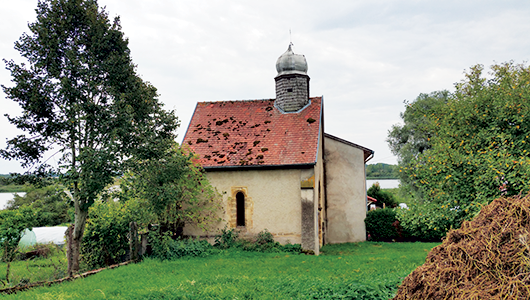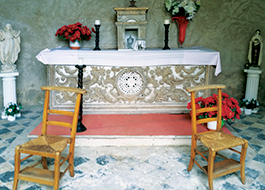Gélucourt
Durée visite : 15 minutes
Moyen : Pédestre
Le nom de Gélucourt apparaît dans le Saulnois à la fin du VIIIe siècle. On connaît un chevalier Guillaume de Gellocourt vers 1189. Jusqu’en 1264, Gélucourt est une grange de la commanderie des templiers de Vic-sur-seille. A cette date, elle devient une commanderie. Une commanderie est un ensemble de bâtiments. Il tient à la fois du monastère et de la ferme de rapport. Ils sont destinés à procurer des fonds, pour soutenir l’action des templiers en Terre Sainte. Après leur anéantissement, en 1312, ils sont remplacés par les chevaliers de Saint-Jean de Jérusalem. Ceux-ci sont plus connus sous le nom d’hospitaliers. C’est aujourd’hui l’Ordre de Malte. En 1525 ,une coalition de seigneurs lorrains germanophones se rassemble à Gélucourt. Ils s’en vont réprimer la révolte des paysans, qui a embrasé le Sud-Ouest du Saint-Empire. Au XVIIe siècle, le village est détruit pendant la Guerre de Trente-Ans.
The name of Gélucourt appears in Saulnois at the end of the 8th century. We know a knight Guillaume de Gellocourt around 1189. Until 1264, Gélucourt was a barn of the commandery of the templars of Vic-sur-seille. On this date, it becomes a commandery. A commandery is a group of buildings. He is responsible for both the monastery and the income farm. They are intended to provide funds, to support the action of the Templars in the Holy Land. After their annihilation, in 1312, they were replaced by the Knights of Saint John of Jerusalem. These are better known as the hospitable. Today it is the Order of Malta. In 1525, a coalition of German-speaking lords from Lorraine gathered in Gélucourt. They go to suppress the revolt of the peasants, which set ablaze the southwest of the Holy Empire. In the 17th century, the village was destroyed during the Thirty Years War.
Der Name Gélucourt erscheint Ende des 8. Jahrhunderts in Saulnois. Wir kennen einen Ritter Guillaume de Gellocourt um 1189. Bis 1264 war Gélucourt eine Scheune des Kommandanten der Templer von Vic-sur-Seille. An diesem Tag wird es eine Kommandantur. Eine Kommandantur ist eine Gruppe von Gebäuden. Er ist sowohl für das Kloster als auch für die Einkommensfarm verantwortlich. Sie sollen Mittel bereitstellen, um das Handeln der Templer im Heiligen Land zu unterstützen. Nach ihrer Vernichtung wurden sie 1312 durch die Ritter des Heiligen Johannes von Jerusalem ersetzt. Diese sind besser als Hospitaliers bekannt. Heute ist es der Malteserorden. 1525 versammelte sich in Gélucourt eine Koalition deutschsprachiger Herren aus Lothringen. Sie gehen, um den Aufstand der Bauern zu unterdrücken, der den Südwesten des Heiligen Reiches in Brand setzte. Im 17. Jahrhundert wurde das Dorf während des Dreißigjährigen Krieges zerstört.

D’argent au mont de sable enflammé de gueules sommé d’une croix de Malte d’azur.
La croix de Malte rappelle que Gélucourt appartint à cet Ordre ; le mont enflammé est l’emblème de saint Brice, patron.
Argent a mount Sable inflamed Gules topped with a Maltese cross Azure.
The Maltese cross recalls that Gélucourt belonged to this Order; the flaming mount is the emblem of Saint Brice, patron.
Argent ein Berg Sable flammenden Gules mit einem Malteserkreuz Azure gekrönt.
Das Malteserkreuz erinnert daran, dass Gélucourt zu diesem Orden gehörte; Das brennende Reittier ist das Wahrzeichen des Schutzpatrons Saint Brice.

Lés oyes de Jelicot = les oies de Gélucourt.
Evidemment, il ne s’agit guère des habitants, mais d’une préparation culinaire dont les gens de ce village ont le secret. On profite cependant de l’équivoque quand on veut s’amuser aux dépens de ceux-ci.
Réf. Les Evangiles d’Imling – Zéliqzon, Dictionnaire, p. 487
Lés oyes de Jelicot = geese from Gélucourt.
Obviously, it is hardly a question of the inhabitants, but of a culinary preparation of which the people of this village have the secret. However, we take advantage of the ambiguity when we want to have fun at the expense of them.
Ref. The Gospels of Imling – Zéliqzon, Dictionary, p. 487
Lés oyes de Jelicot = Gänse aus Gélucourt.
Offensichtlich geht es kaum um die Einwohner, sondern um eine kulinarische Zubereitung, deren Geheimnis die Bewohner dieses Dorfes haben. Wir nutzen jedoch die Mehrdeutigkeit, wenn wir auf Kosten Spaß haben wollen.
Ref. Die Evangelien von Imling – Zeliqzon, Wörterbuch, p. 487
Les points de visites
.
Une première chapelle est construite par les templiers au XIIIe siècle. Elle est plusieurs fois remaniée par les hospitaliers, leurs successeurs. Des travaux récents ont rendu à cette chapelle un peu de l’aspect qu’elle avait au XVIIIe siècle. Un clocheton baroque surmonte l’édifice. La nef a disparu. Il ne reste que le chœur ouvert sur l’extérieur par un arc triomphal en ogive. La partie gauche est soutenue par un épais contre-fort. Le mur méridional est percé d’une fenêtre aveugle en plein cintre. Le mur gauche est éclairé par une fenêtre identique . Les deux fenêtres ne se font pas face. On peut apercevoir un autel baroque en bois doré très délabré. À gauche de l’entrée, à l’intérieur, une pierre tombale est dressée contre le mur. Elle porte une inscription funéraire, Frère Barthélémy Oriesme, vivant religieux de l’ordre de Saint-Jean de Jérusalem, Commandeur de Gélucourt, qui décéda le 21 décembre 1628. De part et d’autre de la porte, subsistent deux colonnes adossées portant des chapiteaux à feuillages. Ils supportent les bases des arcs formerets et de la Croisée d’ogives. La voûte a disparu et la charpente du toit repose sur les murs. Des éléments gothiques ont été réutilisés lors des différentes reconstructions de la chapelle.
A first chapel was built by the Templars in the 13th century. It has been revised several times by the Hospitallers, their successors. Recent works have given this chapel back a bit of the appearance it had in the 18th century. A baroque bell tower surmounts the building. The nave has disappeared. Only the choir remains open to the outside by a pointed triumphal arch. The left part is supported by a thick buttress. The southern wall is pierced with a blind semicircular window. The left wall is lit by an identical window. The two windows do not face each other. You can see a very dilapidated baroque gilded wood altar. To the left of the entrance, inside, a tombstone stands against the wall. It bears a funeral inscription, Brother Barthélémy Oriesme, living religious of the Order of Saint John of Jerusalem, Commander of Gélucourt, who died on December 21, 1628. On either side of the door, there are two back-to-back columns bearing capitals with leaves. They support the bases of the formeret arches and the Crossed ribs. The vault has disappeared and the roof frame rests on the walls. Gothic elements were reused during the various reconstructions of the chapel.
Eine erste Kapelle wurde im 13. Jahrhundert von den Templern erbaut. Es wurde mehrmals von den Hospitalisten, ihren Nachfolgern, überarbeitet. Neuere Arbeiten haben dieser Kapelle etwas mehr Aussehen verliehen als im 18. Jahrhundert. Ein barocker Glockenturm überragt das Gebäude. Das Kirchenschiff ist verschwunden. Nur der Chor bleibt durch einen spitzen Triumphbogen nach außen offen. Der linke Teil wird von einem dicken Pfeiler getragen. Die Südwand ist mit einem blinden halbkreisförmigen Fenster durchbohrt. Die linke Wand wird von einem identischen Fenster beleuchtet. Die beiden Fenster stehen sich nicht gegenüber. Wir können einen Barockaltar aus vergoldetem Holz sehen, der sehr baufällig ist. Links vom Eingang steht innen ein Grabstein an der Wand. Es trägt eine Bestattungsinschrift, Bruder Barthélémy Oriesme, lebender Ordensmann des Ordens des Heiligen Johannes von Jerusalem, Kommandeur von Gélucourt, der am 21. Dezember 1628 starb. Auf beiden Seiten der Tür befinden sich zwei hintereinander angeordnete Säulen Hauptstädte mit Blättern. Sie stützen die Basen der ehemaligen Bögen und der gekreuzten Rippen. Das Gewölbe ist verschwunden und der Dachrahmen ruht an den Wänden. Bei den verschiedenen Rekonstruktionen der Kapelle wurden gotische Elemente wiederverwendet.
.






